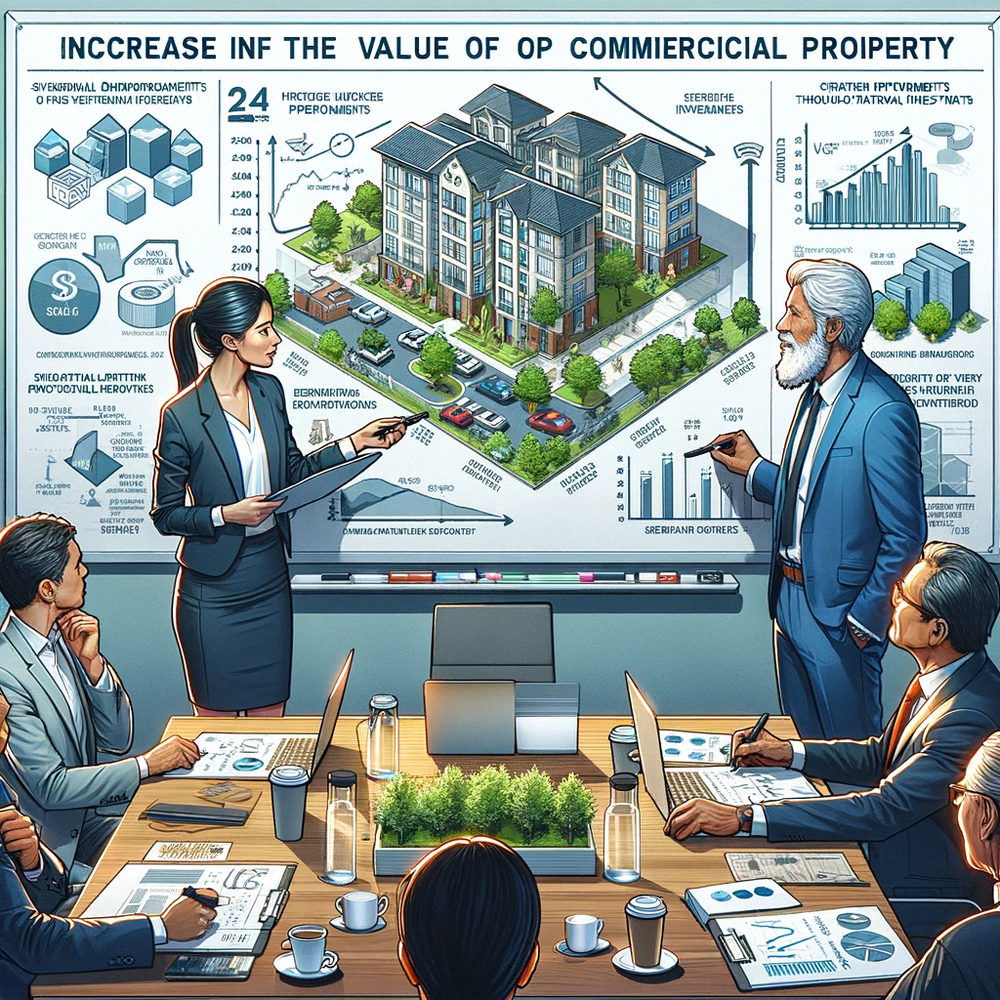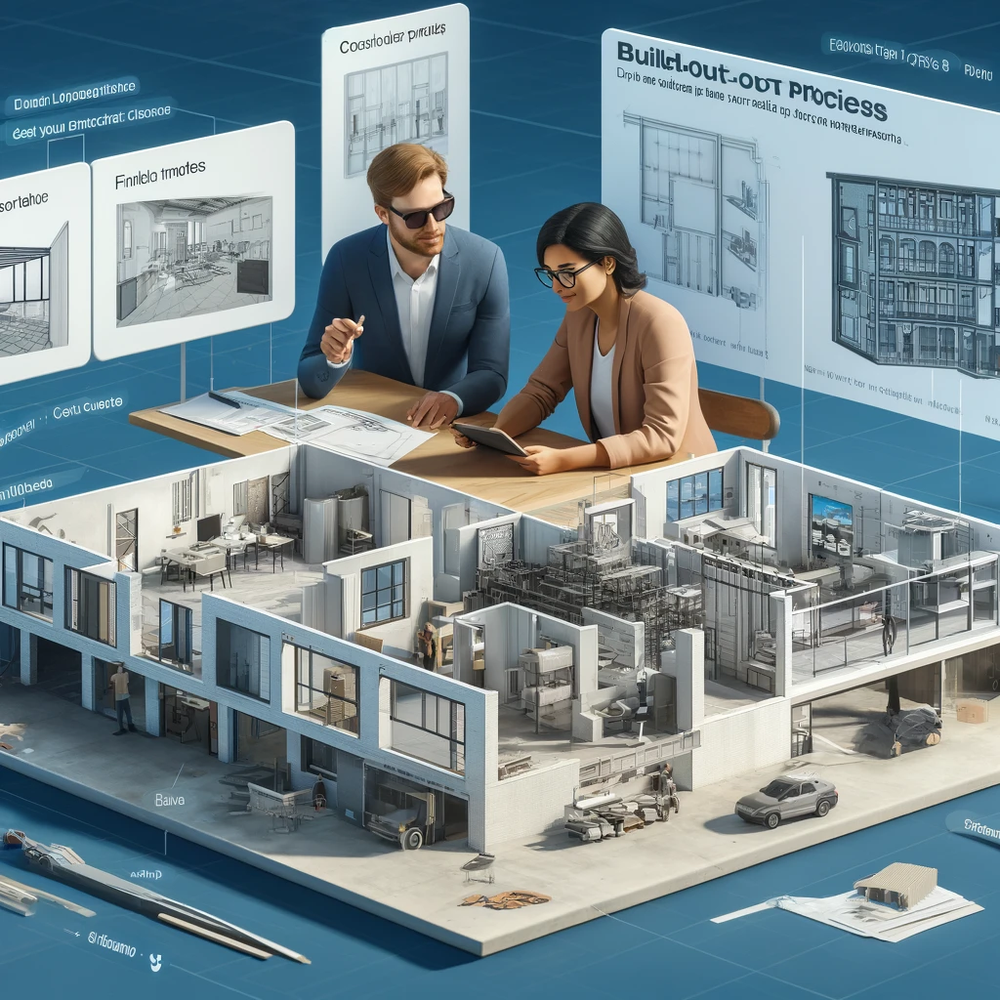Navigating the complexities of commercial real estate requires a deep understanding of leasing fundamentals and market dynamics. From lease structures to investment indicators, each aspect plays a pivotal role in shaping successful transactions. As we delve into the specifics of commercial leasing and investment strategies, we pave the way for informed decision-making in an ever-evolving market landscape.
Table of Contents:
- How does commercial lease structure work?
- How long are typical commercial real estate leases?
- What is tenant improvement allowance in commercial leases?
- How can I increase the value of my commercial property?
- What are the signs of a good commercial real estate investment?
- What impact does public transport accessibility have on commercial property values?
- How does the build-out process work in commercial leases?
- How do changes in interest rates affect commercial real estate?
- What is the best age and condition of commercial property to buy?
- What is the future outlook for commercial real estate?
How does commercial lease structure work?
Commercial lease structures are the backbone of landlord-tenant agreements in the commercial real estate world. Here’s a concise overview of how they work:
- Lease Term: The lease term specifies the duration for which the tenant has the right to occupy the commercial space. It typically ranges from one to ten years or more, with options for renewal or termination.
- Rent Payment: Rent payment details the amount of rent due, the frequency of payment (e.g., monthly, quarterly), and any escalation clauses that may adjust rent over time. Rent may be based on a per-square-foot basis or a percentage of sales for retail properties.
- Common Area Maintenance (CAM) Charges: CAM charges cover the costs of maintaining and operating common areas shared by multiple tenants in a commercial property, such as lobbies, hallways, and parking lots. Tenants are typically responsible for paying a share of these expenses based on their pro-rata share of the property.
- Tenant Improvements: Tenant improvements refer to any modifications or build-outs made to the commercial space to meet the tenant’s specific needs. The lease may outline who is responsible for funding and managing these improvements, as well as any restrictions or approval processes.
- Lease Renewal and Termination: The lease structure specifies the procedures for lease renewal or termination, including notice periods, renewal options, and any penalties or fees associated with early termination.
- Additional Provisions: Commercial leases may include additional provisions covering a range of topics, such as assignment and subletting rights, default and remedies, insurance requirements, and dispute resolution mechanisms.
In essence, commercial lease structures outline the rights and obligations of landlords and tenants regarding occupancy, rent payment, maintenance, improvements, and termination of the lease agreement. Understanding these key elements is essential for both parties to negotiate favorable lease terms and ensure a mutually beneficial landlord-tenant relationship.
How long are typical commercial real estate leases?
The duration of commercial real estate leases is a crucial consideration for both landlords and tenants. Here’s a quick guide to understanding typical lease lengths:
- Short-Term Leases: Short-term leases typically range from one to three years. They offer flexibility for tenants who may have uncertain business needs or prefer to test a location before committing to a longer lease term. Short-term leases are common in industries with rapidly changing market conditions, such as technology startups or retail pop-up shops.
- Medium-Term Leases: Medium-term leases typically range from three to five years. They strike a balance between flexibility and stability, providing tenants with a longer commitment while still allowing for potential changes in business needs. Medium-term leases are popular among small to medium-sized businesses and professional service firms.
- Long-Term Leases: Long-term leases typically range from five to ten years or more. They offer stability and predictability for both landlords and tenants, allowing tenants to establish roots and landlords to secure steady rental income over an extended period. Long-term leases are common among established businesses, anchor tenants, and institutional investors.
- Customized Lease Terms: Lease lengths can vary widely depending on factors such as property type, market conditions, tenant requirements, and landlord preferences. Some leases may include options for renewal or termination, rent escalation clauses, or other customized terms to meet the needs of both parties.
- Market Trends: Market trends can influence lease lengths, with shorter lease terms becoming more common in dynamic markets with high demand and rapid turnover, while longer lease terms may be preferred in stable markets with low vacancy rates and strong tenant demand.
The length of commercial real estate leases varies depending on factors such as tenant preferences, market conditions, and property type. Understanding typical lease lengths and considering factors such as flexibility, stability, and market trends can help landlords and tenants negotiate lease terms that align with their respective needs and objectives.
What is tenant improvement allowance in commercial leases?
Tenant Improvement Allowance (TIA) is a key component of many commercial leases, offering valuable benefits for both landlords and tenants. Here’s a quick guide to understanding TIA:
- Definition: Tenant Improvement Allowance (TIA) is a negotiated amount of money provided by the landlord to the tenant to cover the cost of customizing or improving the commercial space to meet the tenant’s specific needs. It can be used for renovations, build-outs, or upgrades to the interior of the leased premises.
- Tenant Benefits: TIA provides tenants with the financial resources needed to customize the commercial space to their unique requirements. This may include installing fixtures, upgrading finishes, reconfiguring layout, or adding specialized equipment. TIA allows tenants to create a space that enhances their brand image, improves workflow, and meets their operational needs without incurring significant upfront costs.
- Landlord Considerations: For landlords, offering TIA can make the leased space more attractive to prospective tenants and help secure long-term leases. By investing in tenant improvements, landlords can enhance the marketability of their property, attract higher-quality tenants, and command premium rents. TIA also incentivizes tenants to commit to longer lease terms, providing stability and predictability for landlords.
- Negotiation Process: The amount of TIA provided and the terms of its use are typically negotiated as part of the lease agreement. Tenants should carefully consider their space requirements and budgetary constraints when negotiating TIA provisions. Landlords, on the other hand, should assess the financial feasibility of providing TIA and consider factors such as the creditworthiness of the tenant and the potential return on investment.
- Common Uses: TIA can be used for a wide range of tenant improvements, including interior build-outs, installation of HVAC systems, electrical and plumbing upgrades, flooring, lighting, and signage. The specific uses of TIA are typically outlined in the lease agreement, along with any restrictions or approval processes.
Tenant Improvement Allowance (TIA) is a valuable tool in commercial real estate leasing that benefits both landlords and tenants. By providing financial support for tenant improvements, TIA allows tenants to customize the space to their needs while enhancing the marketability and value of the property for landlords. Understanding TIA provisions and negotiating them effectively can lead to successful lease transactions that meet the needs of both parties.
How can I increase the value of my commercial property?

Increasing the value of your commercial property is a smart investment strategy that can yield significant returns over time. Here are some quick tips to help you maximize the value of your commercial property:
- Enhance Curb Appeal: First impressions matter. Improve the exterior appearance of your property by maintaining landscaping, updating signage, and refreshing the façade to attract tenants and customers.
- Upgrade Interior Spaces: Invest in interior upgrades and renovations to modernize the property and create a more attractive environment for tenants. Consider updates such as new flooring, lighting fixtures, paint, and common area amenities.
- Optimize Space Utilization: Evaluate the layout and functionality of your property to identify opportunities for space optimization. Repurpose underutilized areas, reconfigure layouts, or add flexible-use spaces to maximize rental income potential.
- Implement Energy Efficiency Measures: Reduce operating costs and appeal to environmentally conscious tenants by implementing energy-efficient upgrades such as LED lighting, HVAC system upgrades, and insulation improvements.
- Enhance Amenities and Services: Offer amenities and services that add value and differentiate your property from competitors. Consider amenities such as fitness centers, conference rooms, on-site dining options, and concierge services to attract and retain tenants.
- Foster Tenant Relationships: Build strong relationships with tenants by providing responsive property management, addressing their needs promptly, and maintaining open communication. Happy tenants are more likely to renew leases and recommend your property to others.
- Stay Ahead of Market Trends: Keep abreast of market trends, tenant preferences, and industry developments to stay competitive and position your property for success. Adapt your property strategy to align with evolving market demands and emerging opportunities.
By implementing these strategies, you can enhance the value of your commercial property, attract quality tenants, and achieve long-term financial success in the dynamic commercial real estate market.
What are the signs of a good commercial real estate investment?
Identifying a promising commercial real estate investment requires keen observation and a sharp eye for opportunity. Here are some key signs to look out for:
- Prime Location: Location is paramount in commercial real estate. Look for properties situated in high-demand areas with strong economic fundamentals, access to transportation hubs, and proximity to amenities, major thoroughfares, and population centers.
- Positive Cash Flow: A good commercial real estate investment generates positive cash flow from rental income that exceeds operating expenses, including mortgage payments, property taxes, insurance, maintenance, and vacancies. Positive cash flow ensures the property’s financial viability and potential for long-term growth.
- High Occupancy Rates: Properties with high occupancy rates indicate strong tenant demand and stable cash flow. Look for properties with a history of consistent occupancy rates or strong leasing activity in the market.
- Favorable Market Conditions: Assess market trends, supply and demand dynamics, and economic indicators to gauge the overall health of the commercial real estate market. Favorable market conditions, such as low vacancy rates, rising rents, and increasing property values, bode well for investment success.
- Diverse Tenant Base: A diverse tenant base reduces risk and enhances stability by spreading occupancy across multiple tenants and industries. Look for properties with a mix of creditworthy tenants, long-term leases, and low tenant turnover rates.
- Potential for Value-Add Opportunities: Identify properties with untapped potential for value-add opportunities, such as renovations, repositioning, or lease-up strategies. Value-add opportunities can enhance the property’s value and increase returns on investment over time.
- Strong Property Fundamentals: Evaluate the property’s physical condition, infrastructure, amenities, and curb appeal. Well-maintained properties with modern amenities and attractive features command higher rents, attract quality tenants, and retain long-term value.
By keeping an eye out for these key signs, you can spot a good commercial real estate investment that has the potential to deliver attractive returns and long-term growth. Remember to conduct thorough due diligence, consult with industry experts, and leverage market insights to make informed investment decisions.
What impact does public transport accessibility have on commercial property values?
Public transport accessibility is a critical factor that can significantly influence the value of commercial properties. Here’s a brief look at its impact:
- Increased Demand: Commercial properties located near public transportation hubs, such as subway stations, bus stops, or light rail stations, experience increased demand from tenants and customers. Easy access to public transit enhances convenience and connectivity, making these properties more desirable.
- Attractiveness to Tenants: Businesses value the convenience of being located near public transportation, as it provides employees with an accessible and cost-effective commuting option. Commercial properties with good public transport accessibility are more attractive to tenants seeking to attract and retain talent.
- Higher Rental Rates: Properties with excellent public transport accessibility command higher rental rates and achieve stronger tenant demand. Businesses are willing to pay a premium for the convenience and accessibility offered by these properties, leading to increased rental income for landlords.
- Enhanced Marketability: Public transport accessibility enhances the marketability of commercial properties, making them more competitive in the leasing market. Properties located near public transportation hubs are easier to lease and experience lower vacancy rates, resulting in more stable cash flow for investors.
- Positive Capital Appreciation: Commercial properties with good public transport accessibility tend to experience higher capital appreciation over time. The increased demand and desirability associated with these properties drive up property values, leading to greater long-term investment returns.
Public transport accessibility plays a crucial role in shaping the value of commercial properties. Properties located near public transportation hubs benefit from increased demand, higher rental rates, enhanced marketability, and positive capital appreciation. Understanding the impact of public transport accessibility is essential for commercial real estate investors looking to maximize the value and potential of their investments.
How does the build-out process work in commercial leases?

The build-out process in commercial leases is a crucial step that defines the customization and improvement of commercial space to meet the needs of tenants. Here’s a concise overview of how it works:
- Initial Assessment: The build-out process begins with an initial assessment of the tenant’s requirements and preferences for the commercial space. This includes determining the desired layout, finishes, fixtures, and any specific needs or upgrades.
- Lease Negotiation: As part of lease negotiations, the tenant and landlord discuss the build-out terms and responsibilities. The lease agreement outlines the scope of the build-out, including who is responsible for funding and managing the construction, timelines, and any restrictions or approvals required.
- Design and Planning: Once the lease terms are agreed upon, the tenant typically works with an architect, designer, or contractor to develop detailed plans and specifications for the build-out. This may include floor plans, electrical layouts, plumbing diagrams, and material selections.
- Permitting and Approvals: Depending on the extent of the build-out and local regulations, permits may be required from the relevant authorities before construction can begin. The tenant or their contractor is responsible for obtaining necessary permits and approvals to ensure compliance with building codes and regulations.
- Construction and Completion: With plans finalized and permits secured, the construction phase begins. The build-out process involves coordinating contractors, managing construction activities, and overseeing quality control to ensure that the space is built according to specifications and within the agreed-upon timeline.
- Final Inspection and Acceptance: Once construction is completed, a final inspection is conducted to verify that the build-out meets the tenant’s requirements and complies with lease terms. Any deficiencies or punch list items are addressed, and the space is formally accepted by the tenant.
- Occupancy and Use: After the build-out is completed and accepted, the tenant can move into the commercial space and commence operations. The landlord may provide a grace period or rent abatement to allow the tenant time to set up and transition into the space.
The build-out process in commercial leases involves careful planning, negotiation, design, construction, and acceptance of customized improvements to the commercial space. By understanding the steps involved and effectively managing the process, both tenants and landlords can ensure a successful build-out that meets the needs of all parties involved.
How do changes in interest rates affect commercial real estate?
Interest rates play a pivotal role in shaping the dynamics of the commercial real estate market, influencing investment decisions, financing costs, and property values. Here’s a quick look at how changes in interest rates can impact commercial real estate:
- Financing Costs: Changes in interest rates directly affect the cost of borrowing for commercial real estate investments. When interest rates rise, borrowing costs increase, leading to higher mortgage payments and reduced affordability for property buyers. Conversely, lower interest rates can make financing more affordable, stimulating investment activity and boosting property values.
- Investment Returns: Fluctuations in interest rates can impact investment returns for commercial real estate investors. Rising interest rates may reduce property values and rental income potential, resulting in lower investment returns. Conversely, falling interest rates can increase property values and rental income, enhancing investment returns for property owners.
- Cap Rates: Changes in interest rates can influence capitalization (cap) rates, which measure the expected rate of return on a commercial property investment. When interest rates rise, investors may demand higher cap rates to compensate for increased financing costs and perceived investment risk. Conversely, falling interest rates may lead to lower cap rates as investors accept lower yields in a low-rate environment.
- Investor Sentiment: Interest rate changes can impact investor sentiment and confidence in the commercial real estate market. Rising interest rates may signal tighter monetary policy and economic uncertainty, leading to cautious investor behavior and reduced investment activity. Conversely, declining interest rates can boost investor confidence and stimulate investment demand, driving up property prices and transaction volumes.
- Tenant Demand: Interest rate changes can indirectly affect tenant demand for commercial real estate space. Rising interest rates may dampen economic growth and business expansion, leading to softer tenant demand and higher vacancy rates in certain sectors. Conversely, falling interest rates can stimulate economic activity and business investment, increasing tenant demand for commercial space.
Changes in interest rates have far-reaching implications for the commercial real estate market, impacting financing costs, investment returns, cap rates, investor sentiment, and tenant demand. By staying informed about interest rate trends and understanding their impact on commercial real estate, investors can make informed decisions and navigate market fluctuations effectively.
What is the best age and condition of commercial property to buy?
When it comes to buying commercial property, determining the ideal age and condition can be a critical decision. Here’s a quick guide to help you make the right choice:
- Newer Properties: New or recently constructed commercial properties offer modern amenities, updated infrastructure, and attractive features that appeal to tenants and investors. They typically require minimal maintenance and repairs, providing a hassle-free ownership experience. Newer properties also tend to command higher rental rates and property values, offering potential for strong returns on investment.
- Well-Maintained Older Properties: Well-maintained older properties with good bones and timeless design features can also be attractive investment opportunities. These properties may offer unique architectural charm, established neighborhoods, and prime locations that appeal to tenants and customers. With proper maintenance and upgrades, older properties can be renovated and revitalized to meet modern standards and tenant preferences.
- Value-Add Opportunities: Properties in need of renovation or repositioning present value-add opportunities for savvy investors. These properties may be priced lower due to their condition but offer potential for significant appreciation and rental income growth with strategic improvements. Value-add opportunities can include upgrading amenities, renovating interiors, or rebranding the property to attract higher-quality tenants.
- Market Demand and Location: Consider the demand for commercial properties in your target market and location. Evaluate factors such as population growth, job creation, infrastructure development, and economic trends to assess the potential demand for commercial space. Properties located in high-demand areas with strong market fundamentals may present attractive investment opportunities regardless of age or condition.
- Budget and Investment Goals: Ultimately, the best age and condition of commercial property to buy depend on your budget, investment goals, risk tolerance, and preferences. Assess your investment objectives, financial resources, and long-term strategy to determine the most suitable property type and condition that align with your goals.
The best age and condition of commercial property to buy depend on various factors, including market demand, location, budget, investment goals, and value-add potential. Whether you prefer newer properties with modern amenities, well-maintained older properties with character, or value-add opportunities with renovation potential, carefully consider your options to make an informed investment decision that maximizes returns and meets your objectives.
What is the future outlook for commercial real estate?

In the ever-evolving landscape of commercial real estate, staying ahead of future trends and developments is essential for success. Here’s a concise overview of the future outlook for commercial real estate:
- Resilience and Adaptability: Despite challenges posed by economic uncertainties and market disruptions, commercial real estate has demonstrated resilience and adaptability. The future outlook remains positive, with continued demand for well-located, high-quality properties across various sectors.
- Technology Integration: Technology will continue to play a transformative role in shaping the future of commercial real estate. Advancements in proptech, IoT, artificial intelligence, and data analytics will drive innovation in property management, tenant experience, and building operations.
- Flexible Work Environments: The rise of remote work and flexible work arrangements will impact office space demand and design. Companies are reevaluating their office footprints, with a focus on creating agile workspaces that accommodate hybrid work models and prioritize collaboration, wellness, and employee experience.
- E-commerce Growth: The accelerated adoption of e-commerce will drive demand for industrial and logistics properties. Warehousing, distribution centers, and last-mile delivery facilities will continue to be in high demand to support the expansion of online retail and logistics networks.
- Sustainability and ESG: Environmental, social, and governance (ESG) considerations will become increasingly important in commercial real estate. Investors, tenants, and regulators are placing greater emphasis on sustainability, energy efficiency, and responsible investment practices, driving demand for green buildings and sustainable development.
- Urban Revitalization: Urban areas are experiencing a resurgence as millennials and young professionals flock to city centers in search of vibrant live-work-play environments. Mixed-use developments, transit-oriented developments, and urban infill projects will continue to thrive, offering opportunities for investors and developers.
- Market Dynamics: Market dynamics will vary by sector, location, and property type. While certain sectors may face challenges, others will present opportunities for growth and investment. Understanding market trends, tenant preferences, and demographic shifts will be essential for navigating future opportunities and challenges in commercial real estate.
In conclusion, the future outlook for commercial real estate is characterized by resilience, technology integration, flexibility, sustainability, and urbanization. By staying informed about future trends and developments, commercial real estate professionals can adapt their strategies and capitalize on emerging opportunities to achieve long-term success in a dynamic and evolving market.
Conclusion
Understanding the intricacies of commercial real estate leasing, from lease structures to tenant improvement allowances, is crucial. Recognizing signs of a good investment and adapting to market trends guide informed decision-making. Looking ahead, technology, sustainability, and urbanization will reshape the landscape, offering opportunities for those embracing flexibility and innovation.
Unlock the Full Potential of Your Commercial Real Estate Investments—Let’s Navigate the Market Together!
Whether you’re leasing, investing, or strategizing for long-term growth, understanding the intricacies of commercial real estate is essential to making profitable decisions. Don’t navigate this complex landscape alone—our expert guidance can help you maximize property value, secure favorable lease terms, and stay ahead of market trends. Contact us today at 502-536-7315 or email raphael@sumcg.com to gain the insights and strategies you need to succeed in commercial real estate!
